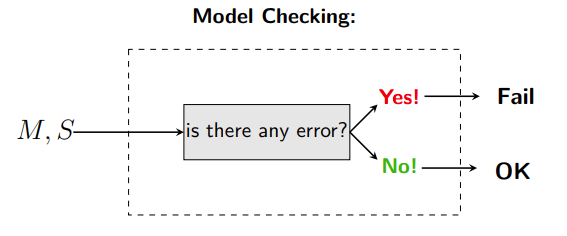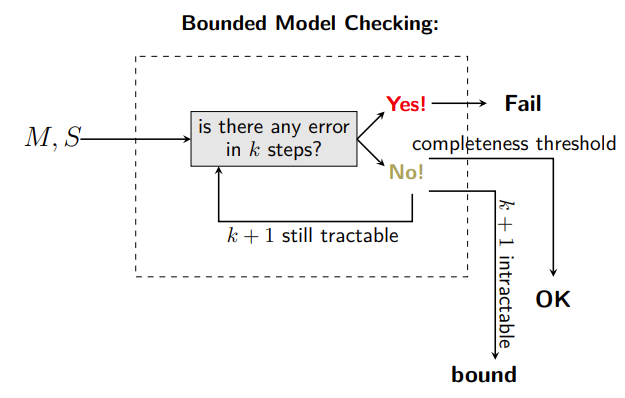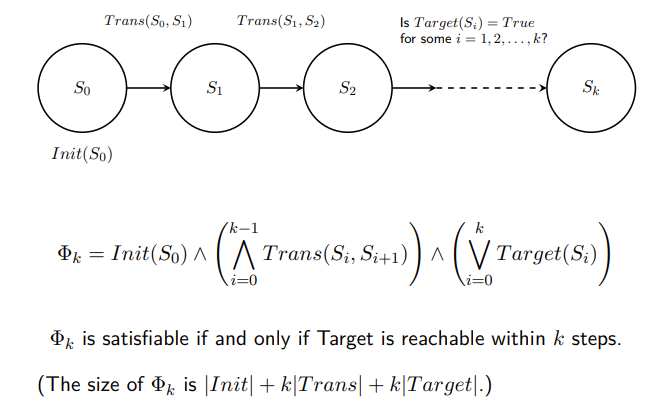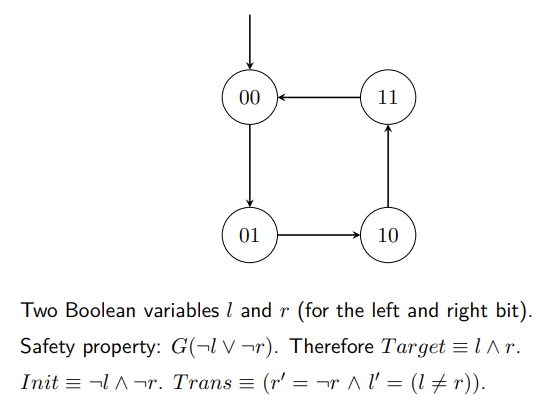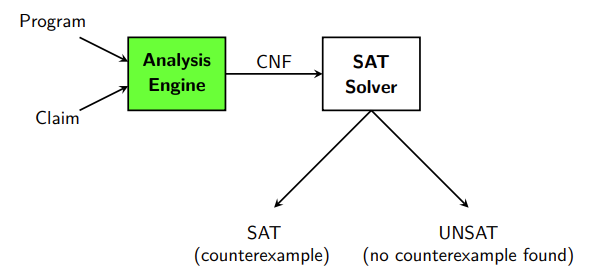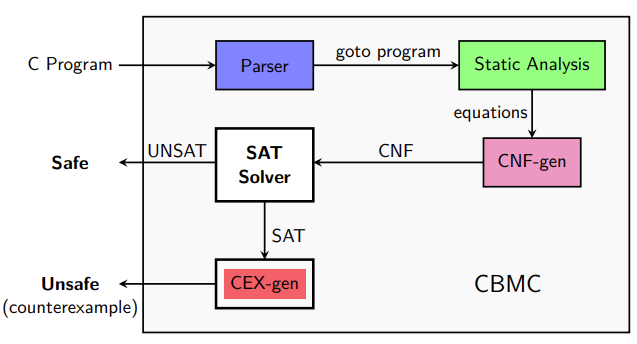What is Bounded Model Checking? Why bounded?
- Model Checking is supposed to be exhaustive, i.e. the whole state space of the system is explored.
- In real world systems, the number of states is usually too big (state space explosion problem).
- We can explore only a subset of the state space: Bounded Model Checking (BMC)
Model Checking versus Bounded Model Checking
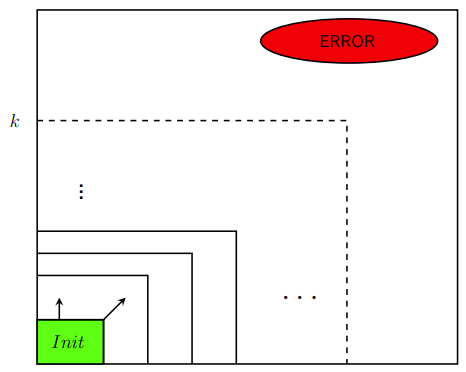 BMC: check if a property holds for a subset of states
BMC: check if a property holds for a subset of states
Bounded Model Checking for Reachability
- Given a positive integer
k, is the Target reachable inksteps? (Think of Target as defining bad states.) - We encode a BMC problem as a SAT problem.
- The Bounded Model Checking problem
X, Init(X), T arget(X), T rans(X, X′), k, is transformed into a Boolean formulaΦk. Φkis satisfiable iff(if and only if) Target is reachable from Init within k steps following Trans.
Example: Two Bit Counter
 encode a BMC problem as a SAT problem
encode a BMC problem as a SAT problem
Φ2is unsatisfiable (hence, no proof of violation of the safety property).Φ3(l3 = 1,r3 = 1) is satisfiable (so the safety property is violated).
Main idea: Given a program and a claim, use a SAT solver to check of there is an execution that violates the claim.
CNF stands for Conjunctive Normal Form. It is a way of structuring logical expressions in a form where a series of AND operations (conjunctions) are applied to OR expressions (disjunctions) of literals. A literal is either a variable or the negation of a variable.
CBMC: How Does It Work?
CBMC: the C (Program) Bounded Model Checker
Transforms a C program into a set of equations:
- Simplify control flow
- Unwind all the loops
- Convert into Single Static Assignment (SSA)
- Convert into equations
- Bit-blast
- Solve with a SAT solver
- Convert SAT assignment into a counterexample
Control Flow Simplification
- All side effects are removed
- e.g.
j=i++; is transformed intoj=i; i=i+1;
- e.g.
- Control flow is made explicit
continueandbreakare replaced bygoto
- All loops are simplified into one form
- e.g.
for,do,whileare replaced by justwhile
- e.g.
Loop Unwinding
- All loops are unwound
- use different unwinding bounds for different loops
- check whether unwinding is sufficient using a special unwinding assertion
- If a program satisfies all of its claims and all unwinding assertions, then it is correct.
- Recursive functions and backward goto are similar (use inlining).
1
2
3
4
5
6
7
void f(...) {
... // some code
while(cond){
Body;
}
Remainder;
}
whileloops are unwound iteratively;break/continuereplaced bygoto.
1
2
3
4
5
6
7
8
9
10
11
12
13
14
15
16
void f(...) {
... // some code
if (cond) {
Body;
if (cond) {
Body;
if (cond) {
Body;
while (cond) {
Body;
}
}
}
}
Remainder;
}
- Assertion inserted after last iteration: violated if the program runs longer than bound permits. Positive correctness result!
1
2
3
4
5
6
7
8
9
10
11
12
13
14
void f(...) {
... // some code
if (cond) {
Body;
if (cond) {
Body;
if (cond) {
Body;
assert (!cond); //Unwinding assertion
}
}
}
Remainder;
}
Example
Transforming Loop-Free Programs Into Equations
It is trivial to translate a program into a set of equations if each variable is only assigned once!
1
2
3
x = a;
y = x+1;
z = y-1;
This program is directly transformed into: x = a ∧ y = x + 1 ∧ z = y − 1
Static Single Assignment
Static Single Assignment (SSA) form:
- Every variable is assigned exactly once.
- Every variable is defined before it is used.
1
2
3
x=x+y;
x=x*2;
a[i]=100;
When a variable is assigned multiple times, we use a new variable for each assignment:
1
2
3
x1 = x0 + y0;
x2 = x1*2;
a1[i0] = 100;
1
2
3
4
5
if(v)
x = y;
else
x = z;
w = x;
Converting conditionals to SSA:
1
2
3
4
5
6
if(v0)
x0 = y0;
else
x1 = z0;
x2 = v0 ? x0 : x1;
w1 = x2;
Example 1
1
2
3
4
5
6
7
8
int y;
int x;
x = x + y;
if (x != 1)
x = 2;
else
x++;
assert (x <= 3);
Convert to SSA (Static Single Assignment form):
1
2
3
4
5
6
7
x1 = x0 + y0;
if (x1 != 1)
x2 = 2;
else
x3 = x1 + 1;
x4 = (x1 != 1) ? x2 : x3;
assert (x4 <= 3);
Generate constraints (if SAT, then assertion is false):
x1 = x0 + y0 ∧ x2 = 2 ∧ x3 = x1 + 1
∧ ((x1 ≠ 1 ∧ x4 = x2) ∨ (x1 = 1 ∧ x4 = x3)) [selector]
∧ ¬(x4 ≤ 3) [negated assertion]
Example 2 (with a Loop)
1
2
3
4
5
6
7
int i;
int p;
p=5;
for (i=0; i<=n; i++) {
p = p * m;
}
assert(p>=5);
Transform the for loop into a while loop:
1
2
3
4
5
6
7
8
int i;
int p;
p = 5; i = 0;
while (i <= n) {
p = p * m;
i = i + 1;
}
assert(p >= 5);
Unroll the loop twice and add an assume statement to exit the loop:
1
2
3
4
5
6
7
8
9
10
11
12
13
int i;
int p;
p = 5; i = 0;
if (i <= n) {
p = p * m;
i = i + 1;
if (i <= n) {
p = p * m;
i = i + 1;
assume(!(i <= n));
}
}
assert(p >= 5);
Assign all variables exactly once, compute guards for conditionals and add conditionals for merging values:
1
2
3
4
5
6
7
8
9
10
11
12
p1 = 5;
i1 = 0;
g1 = i1 <= n1
p2 = p1 * m1; // g1
i2 = i1 + 1; // g1
g2 = i2 <= n1
p3 = p2*m1 //g1 && g2
i3 = i2 + 1; //g1 && g2
assume(!(i3 <= n1));
p4 = g1 ? (g2 ? p3 ? p2) : p1;
i4 = g1 ? (g2 ? i3 : i2) : i1; // i4 unused
assert(p4 >= 5);
Convert to logical expression (if UNSAT, then assertion holds):
p1 = 5
∧ i1 = 0
∧ g1 = (i1 ≤ n1)
∧ p2 = p1 ∗ m1
∧ i2 = i1 + 1
∧ g2 = (i2 ≤ n1)
∧ p3 = p2 ∗ m1
∧ i3 = i2 + 1
∧ ¬(i3 ≤ n1) [assume statement]
∧ p4 = g1 ? (g2 ? p3 : p2) : p1
∧ i4 = g1 ? (g2 ? i3 : i2) : i1
∧ ¬(p4 ≥ 5) [assert statement]
